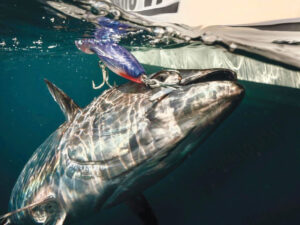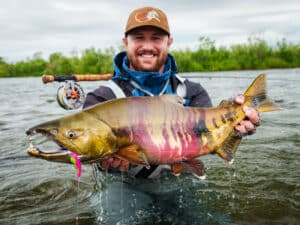Catching a 50-pounder is the goal of almost every striper addict. Most 50-pounders are hooked in Northern waters, where rocks and other structure provide old, lazy bass the opportunity to nail a meal without expending much energy or risk. Yet, there’s also a place where 50s and 60s gather in open waters during winter — and though Virginia anglers call them “rock” or rockfish, there’s not a rock in sight.
The migratory urge and rapidly cooling Northern waters pull those trophy insiders from their favored haunts and send them south toward spawning rivers in Chesapeake Bay. Catching a 50 among the many 30- to 40-pound stripers is still a gamble, but at least you don’t have to know the precise location of an underwater boulder and exactly when the bass of your dreams might be there. Then, when you hook it, there aren’t any rocks for it to dive into or lobster pot lines to tangle in.
The winter run off Virginia also gives trophy hunters a huge advantage. Those fish are in prime condition after a season of feeding in the north before heading south, following schools of menhaden. Not only are the striped bass in top shape, but their bellies often sag with roe to be deposited within a few months, considerably adding to their weight (the average size in midwinter seems to be around 35 pounds) and emphasizing the importance of using circle hooks to ensure effective releases. Under the circumstances, the possibility of going right past the 50-pound mark is likely.
Catches of Record
Billy Steadman of Toms River, New Jersey, spends December in Virginia with his wife, Linda, in a rented house so they can fish every decent day. Linda reels in most of the bass, but on Dec. 21, 2011, she was tied up with a routine 35-pounder, and Billy grabbed another rod that bent over. That bass turned out to be a 51½-incher, but with a 32½-inch girth that brought its weight up to 63 pounds, 8 ounces, weighed at Chris’ Bait & Tackle. It was beaten in the Virginia state tournament by a bass 11 ounces larger that was boated on the last day of the year. The Virginia state record of 74 pounds was trolled in January 2012 from the open waters off Cape Henry.
For strictly catch-and-release anglers like Chuck Many of Annandale, New Jersey, when the Chesapeake Bay season closes in December, the best is often still to come. Many — a former American Striper Association Angler of the Year — trailers his Tyman, a 28-foot True World to Cape Charles late in the fall to berth at Bay Creek Marina.
Warm Up
I drove south this past January with Dennis Tarnowski of East Windsor and Capt. Lou Grazioso of Wall, New Jersey, to meet up with Nellie Greer of Bethlehem, Pennsylvania, for a day of fishing with Many. En route, Many called from his boat to report a 52-pounder and three bass in the mid-30s while fishing by himself.
The next day, the 15- to 20-mile-per-hour southwest wind provided less-than-ideal conditions for the “bobber” fishing with eels that’s become a standard Virginia technique. Despite the 60-foot depths where Many concentrates his efforts, bobbers are set to hold eels often at depths of only 10 to 25 feet under the surface, as Virginia stripers are usually suspended.The eels are rigged on circle hooks on 20-pound mono leaders, as Many feels he gets more hits with the light leader.
The rods are spread out in rod holders along the gunnel, and fished in gear. When a hit occurs, the angler only has to turn the handle as quickly as possible to come tight on the circle hook before picking up the rod for the fight.
Though there was no surface indication of menhaden, Many found bait on his fish finder in an 80-foot trench that provided all the clues he needed.
He warned us that we might get bored staring at bobbers for hours, but he’s willing to wait for even one bite because it will almost surely be a big bass. Actually, it didn’t take too long that morning, and I was soon wrestling a bass from the bow, applying lots of pressure, unaware at the time of the light, 20-pound leader. After bringing it alongside, Many weighed it on his IGFA-certified Boga Grip at 51½ pounds before a couple of photos and a quick release.
Only minutes later, Tarnowski released his personal best, a 45-pound striper, and the count was up to 12 by the time we headed back with the sun setting. All of those bass were at least in the 30s.
Back for More
That fishing we experienced was so good, I gave up the Super Bowl to fish with Many, Greer, Grazioso and Art Berkman. It was normal winter weather the first morning. Frost covered the Bay Creek Marina dock, but drifting conditions were perfect with a light north wind. The bite didn’t turn on until the afternoon, but we located fish with the sounder, and Grazioso promptly hooked up on a 9-inch Tsunami Shad. I dropped a 7-inch Tsunami Shad on a spinning outfit, and both of us shortly released 36-pounders. Our release count for the day ended up at 13, topped by Greer’s 41-pounder.
The next day started well with Berkman’s 45-pound release. The afternoon bite started with my 47-pounder that hit a live eel fished a few turns over bottom on a split-shot.
Many found some American Littoral Society tags, and I applied them to that jumbo plus a couple of others, including a mere 22-pounder that hit the 7-inch Tsunami Shad, and we ended the day with 16 releases.
The fishing was all you could ask for in midwinter, except for the lack of 50s and the 60 that Many has been seeking for years. I noted that most people would look at those 45- and 47-pounders and say, “They’re so close; what’s the difference?” To which Many replies, “We know the difference!












